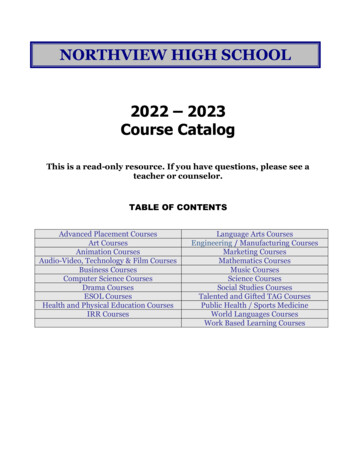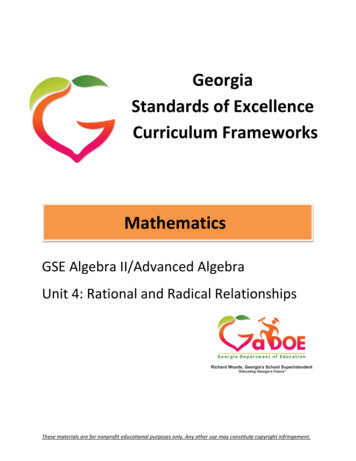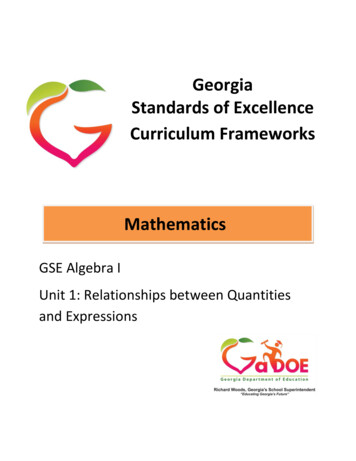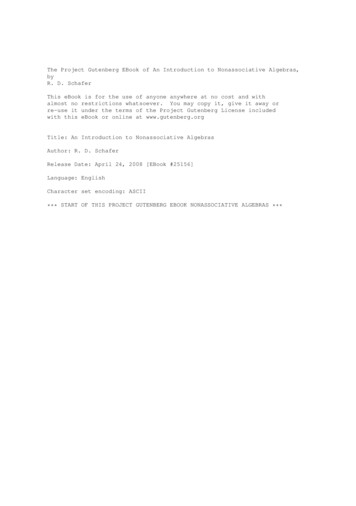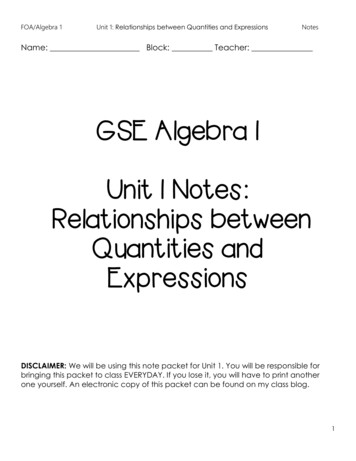
Transcription
FOA/Algebra 1Unit 1: Relationships between Quantities and ExpressionsNotesName: Block: Teacher:GSE Algebra 1Unit 1 Notes:Relationships betweenQuantities andExpressionsDISCLAIMER: We will be using this note packet for Unit 1. You will be responsible forbringing this packet to class EVERYDAY. If you lose it, you will have to print anotherone yourself. An electronic copy of this packet can be found on my class blog.1
FOA/Algebra 1Unit 1: Relationships between Quantities and ExpressionsStandardMGSE9–12.A.SSE.1 Interpret expressions that representa quantity in terms of its context.Sub-StandardNotesLessonMGSE9–12.A.SSE.1a Interpret parts of anexpression, such as terms, factors, andcoefficients, in context.MGSE9–12.A.SSE.1b Given situationswhich utilize formulas or expressions withmultiple terms and/or factors, interpretthe meaning (in context) of individualterms or factors.MGSE9–12.A.APR.1 Add, subtract, and multiplypolynomials; understand that polynomials form asystem analogous to the integers in that they areclosed under these operations. (Operations withpolynomials limited to the second degree.)MGSE9–12.N.RN.2 Rewrite expressions involvingradicals and rational exponents using the propertiesof exponents.MGSE9–12.N.RN.3 Explain why the sum or product ofrational numbers is rational; why the sum of a rationalnumber and an irrational number is irrational; andwhy the product of a nonzero rational number andan irrational number is irrational.MGSE9–12.N.Q.1 Use units of measure (linear, area,capacity, rates, and time) as a way to understandproblems:a. Identify, use, and record appropriateunits of measure within context, withindata displays, and on graphs;b. Convert units and rates usingdimensional analysis (English–to–Englishand Metric–to– Metric without conversionfactor provided and between Englishand Metric with conversion factor);c. Use units within multi–step problemsand formulas; interpret units of input andresulting units of output.MGSE9–12.N.Q.2 Define appropriate quantities forthe purpose of descriptive modeling. Given asituation, context, or problem, students willdetermine, identify, and use appropriate quantitiesfor representing the situation.MGSE9–12.N.Q.3 Choose a level of accuracyappropriate to limitations on measurement whenreporting quantities. For example, money situationsare generally reported to the nearest cent(hundredth). Also, an answers’ precision is limited tothe precision of the data given.2
FOA/Algebra 1Unit 1: Relationships between Quantities and ExpressionsNotesUnit 1:Relationships between Quantities and ExpressionAfter completion of this unit, you will be able to Learning Target #1: Algebraic Expressions Review creating an expression from a verbal description Review interpreting parts of an Expression in terms of a contextLearning Target #2: Operations with Polynomials Classify polynomials by degree and terms Add polynomials Subtract polynomials Multiply polynomials Apply operations of polynomials to real world problemsLearning Target #3: Radical Expressions Simplify Radical Expressions Multiply Radical Expressions Add & Subtract Radical Expressions Rational & Irrational NumbersMondayTuesday12th18th19thDay 6 –Quick Check onClassifying, Add&Subtract Polynomials.Multiplying Polynomials(Area Model)December 2ndDay 11 Review Laws ofExponents/PerfectSquares/SimplifyingRadical Expressions9thDay 16 –1 & 2-Step DimensionalAnalysisDay 2 –Creating AlgebraicExpressions from aContextDay 7 –More PracticeMultiplyingPolynomials/RealWorld Applications(Perimeter/Area)3rdDay 12 –Multiplying RadicalExpressions10thDay 17 – Multi-StepDimensional Analysis& Rate ConversionPageDay 1: Review Parts of andSimplifying Algebraic ExpressionsDay 2: Creating & TranslatingAlgebraic ExpressionsDay 3 - 5: Classifying/ Adding &Subtracting PolynomialsDay 6 - 9: Multiplying Polynomials46912Day 11 – Review Exponents &Simplifying Square RootsDay 12 – Simplifying Square Roots w/1417Operations & Multiplying Square RootsLearning Target #4: Dimensional Analysis Convert units using dimensional analysis (Metric to Metric &customary to customary) without conversion factor provided Convert units using dimensional analysis (between customary &Metric) with conversion factor provided Define appropriate units for both metric and customary systems Apply dimensional analysis to ratesNovember 11thDay 1 –Review InterpretingExpressions, Terms,Factors, Coefficients &Evaluating ExpressionsTable of ContentsTopicDay 13 – Adding & SubtractingRadicalsDay 15 – The Real Number System –Rational & Irrational NumbersDay 16 - 17 – Converting Units UsingDimensional AnalysisDay 18 – Problem Solving Using UnitsWednesday13thDay 3 –Intro to Polynomials/ClassifyingPolynomials20thDay 8 –Polynomials RealWorld Applications(Perimeter/Area)Thursday14thDay 4 –Adding & SubtractingPolymonials21st5thDay 13 - PracticeMultiplying &Simplifying/ Adding &Subtracting RadicalsDay 14 - RadicalsOperations & Quiz onRadicals11th12thDay 18 Unit 1 Review DayDay 19 –Unit 1 Review Day192125Friday15thDay 5 –Mixed Review:Classifying, Adding &SubtractingPolymonials22ndDay 9 –Mixed Review:Classifying, Adding,Subtracting,MultiplyingPolymonials & WordProblems4th18Day 10 –Quiz on Days 1-76thDay 15 –Rational & IrrationalNumbers13thDay 20 –Unit 1 Test3
FOA/Algebra 1Algebraic ExpressionsNotesDay 1 – Algebraic ExpressionsStandard: MGSE9–12.A.SSE.1aInterpret parts of an expression, such as terms, factors, and coefficients, in context.An expression containing variables (letters), numbers, and operation symbols is called an. An expression does NOT contain an equal sign.An example of an algebraic expression is 5x 7y – 3.In an algebraic expression, there are four different parts: coefficients, variables, constants, and terms.5x 7y - 3Variables are the letters in an expression.Coefficients are the numbers in front of the variables.Constants are the “plain numbers” or termswithout variables.Terms are separated by a or – sign and can be numbersand/or variables.Factors of each term are the numbers or expressions that when multiplied produce a given product.Practice: Complete the table below.ExpressionList TermsList Factors of 1stTermList CoefficientsList VariablesList Constants2x 5z - 3136m3 – 9m2 s – 4x2 7x -14
FOA/Algebra 1Algebraic ExpressionsNotesCombining Like TermsTerms with the same variable raised to the same exponent are like terms.Like: 3x and -7xLike: 2y2 and 6y2Not Like: 4x and 6x2Why?Directions: Simplify the following expressions:4x 6y 3y21. -3x 6x2. y – 3 6 – 2y3.4. 8m 1n – 3 105. 9x – 10x2 7x – 36. x 2y 3x 9y3Distributive PropertyDistributive Property states .1. 5(x 2)2. -3(x – 4)3. -6(-2x – 3)4. 4x - 5(x – 1)5. -2(4 x) 4(2 – 8x) 56. 2(3 x) x(1 – 4x) 5Evaluating ExpressionsWhen you evaluate an expression, you are replacing the variable with what the variable equals:Evaluate 4x – 5when x 6Practice: Evaluate the following expressions if m 7, r 8, and t -2.a. 5m – 6b.rtc. 3m – 5td. t2 – 4r5
FOA/Algebra 1Creating & Translating Algebraic ExpressionsNotesDay 2 – Creating & Translating Algebraic ExpressionsStandard(s): MGSE9–12.A.SSE.1Interpret expressions that represent a quantity in terms of its context.Creating Algebraic ExpressionsReview: TheCommutative and Associative PropertiesCommutative Property of Addition(order doesn’t matter)Associative Property of Addition(grouping order doesn’t matter)5 6 can be written as 6 52 (5 6) can be written as (2 6) 5Commutative Property of Multiplication(order doesn’t matter)Associative Property of Multiplication(grouping order doesn’t matter)5 x 6 can be written as 6 x 5(2 x 5) x 6 can be written as 2 x (6 x 5)AdditionSumIncreased byMore thanCombinedTogetherTotal ofAdded toGainedRaisedPlusSubtractionDifferenceDecreased byMinusLessLess thanFewer thanHow many moreLeftMultiplicationOfProductTimesMultiplied byDouble, TripleTwiceAs muchEachDivisionQuotientRatio ofEachFraction ofOut ofPerDivided bySplitExponentsPowerSquaredCubedUse Parenthesis: The quantity ofSubtraction and Division can be very tricky because order DOES matter unlike Addition and Multiplication.Take a look at the following verbal descriptions:AdditionThe sum of x and 4.MultiplicationThe product of x and 3.SubtractionThe difference of x and 5.DivisionThe quotient of x and 7x decreased by 5The ratio of x and 7Five less than x6
FOA/Algebra 1Creating & Translating Algebraic ExpressionsNotesPractice: Write the expression for each verbal description:1. The difference of a number and 52. The quotient of 14 and 73. y decreased by 174. x increased by 65. The sum of a number and 86. 6 squared7. Twice a number8. 8 more than a third of a number9. 6 less than twice k10. Five divided by the sum of a and b.11. The quotient of k decreased by 4 and 9.12. 2 minus the quantity 3 more than p13. Half of the quantity 1 less than w14. Nine less than the total of a number and 2.15. The product of a number and 3 decreased by 5Practice: Write each as a verbal expression. You may not use the words add, subtract (minus), times, or divide.1.x22. a 93. 5n – 74. 3(y 7)Creating Expressions from a ContextTrey is selling candy bars to raise money for his basketball team. The team receives 1.25 for each candy barsold. He has already sold 25 candy bars.a. If Trey sells 10 more candy bars, how much money will he raise for the basketball team?b. If Trey sells 45 more candy bars, how much money will he raise for the basketball team?c. Write an expression to represent the unknown amount of money Trey will raise for the basketballteam. Let c represent the additional candy bars sold.7
FOA/Algebra 1Creating & Translating Algebraic ExpressionsNotesUnderstanding Parts of an Expressiona. Hot dogs sell for 1.80 each and hamburgers sell for 3.90 each. This scenario can be represented by theexpression 1.80x 3.90y. Identify what the following parts of the expression represent.1.803.90xy1.80x3.90y1.80x 3.90yb. Noah and his friends rent a sailboat for 15 per hour plus a basic fee of 50. This scenario can berepresented by the expression 15h 50.15h15h5015h 50c. A teacher has 600 to spend on supplies. They plan to spend 40 per week on supplies. This scenario can berepresented by the expression 600 – 40w.600-40w-40w600 – 40w8
FOA/Algebra 1Polynomials – Classify, Add, & SubtractNotesDay 3 – Classifying & Adding/Subtracting PolynomialsStandard: MGSE9–12.A.APR.1Add, subtract, and multiply polynomials; understand that polynomials form a system analogousto the integers in that they are closed under these operations.DefinitionFacts/CharacteristicsA is an expression that can haveconstants, variables, and exponents.Polynomials CANNOT contain: Radicals Fractional exponents Negative exponents Polynomials are named by their andnumber of . The degree is the exponent of avariable. Example: What is the degree of thefollowing?Variables in the denominatorExamplesList 3 examples of polynomialsa) 2x2 5x – 3POLYNOMIALSSb) 4x – 3x5 2x2 – 1Non-ExamplesCross off all expressions that are NOTpolynomials:STANDARD FORM - the terms are arranged in order from the exponent to theexponent.DEGREE - the exponent of the variable in the polynomial.Rewrite each polynomial in standard form. Then identify the degree of the polynomial:a. 5x – 6x2 – 4b. -7x 8x2 – 2 - 8x2c. 6(x – 1) – 4(3x2) – x2Standard Form:Standard Form:Standard Form:Degree:Degree:Degree:
FOA/Algebra 1Polynomials – Classify, Add, & SubtractNotesClassifying PolynomialsPolynomials are classified by DEGREE and NUMBER OF TERMS:“First Name”DegreeName“Last Name”ExampleTerms01122334 NameExample4 Complete the table below. Simplify the expressions or put in standard form if necessary.PolynomialDegree# of TermsClassification8x10-24 3x – x27x – 9x 14x2 – 5x3 – 4 5x -12x 3 – 7x2 4x 7x210
FOA/Algebra 1Polynomials – Classify, Add, & SubtractNotesDay 4 & 5 - Adding PolynomialsWhen adding, use the following steps to add polynomials: Get rid of the parentheses first! Identify and combine like terms Make sure final answer is in standard forma. (4x 2 2x 8) (8x 2 3x 1)b. ( 2x 5) ( 4x2 6x 9)Application: Find an expression that represents the perimeter of the house.What does it mean to find the perimeter of an object?Perimeter of the house:Subtracting PolynomialsSubtracting polynomials is like adding polynomials except we must take care of the minus sign first. Subtractingpolynomials require the following steps: Change the sign of the terms in the parentheses after the subtraction signIdentify and combine like termsAdd (Make sure final answer is in standard form)a. (7x2 – 2x 1) – (-3x2 4x – 7)b. (3x2 5x) – (4x2 7x – 1)c. (5x3 – 4x 8) – (-2 3x)d. (3 – 5x 3x2) – (-x 2x2 - 4)11
FOA/Algebra 1Multiplying PolynomialsNotesDay 6 – Multiplying PolynomialsStandard: MGSE9–12.A.APR.1Add, subtract, and multiply polynomials; understand that polynomials form a system analogous tothe integers in that they are closed under these operations.To multiply polynomials, we will use the Area Model.Area Modela. 4x(x 3)b. (x – 3)(x 7)c. (x 5)2d. (x – 4)(x 4)e. (3x 6)(2x – 7)f. (x – 3)(2x2 2)More Practice ProblemsSolve these problems using the Area Model.1) (x – 7)(x 4)2) (x – 9)23) (x 10)(x – 10)4) x(x - 12)6) (4x – 5)(3x – 6)5) (3x 7)(2x 1)12
FOA/Algebra 1Multiplying PolynomialsNotesDay 7 & 8- Applications Using Polynomials1. Write an expression that represents the area and perimeter of this rectangle.2. You are designing a rectangular flower bed that you will border using brick pavers. The width ofthe board around the bed will be the same on every side, as shown.a. Write a polynomial that represents the total area of the flower bed and border.b. Find the total area of the flower bed and border when the width of the border is 1.5 feet.3. Find the expression that represents the area not covered by the mailing label.13
FOA/Algebra 1Simplifying Radicals ExpressionsNotesDay 11 - Simplifying Radical ExpressionsStandard(s): MGSE9–12.N.RN.2Rewrite expressions involving radicals and rational exponents using the properties of exponents.*4 is being multiplied by 10.3*If no index is written, itis assumed to be a 2. 8𝑥 24 10*This is the number orexpression “in the house”.Square Root TableComplete the table below.Square each of thefollowing numbers.12345678910xPerfect SquaresTake the square root ofeach of your perfectsquares.Square RootsTaking square roots and squaring a number are or they undo each other, just like adding andsubtracting undo each other.Review: FactorsA factor is a or mathematical that divides another number or expressionevenly.Example: What are the factors of the following?a) 24b) 45c) 17d) y414
FOA/Algebra 1Simplifying Radicals ExpressionsNotesSimplifying RadicalsA radical expression is in simplest form if no perfect square factors other than 1 are in the radicand(ex.20 4 5 )Guided Example: Simplify 80 .Step 1: Find the factors of the number inside theradical.Step 2: Chose the pair of factors that containsthe largest perfect square.Step 3: Find the square root of the perfectsquare and leave the other root as is, since itcannot be simplified.Step 4: Simplify the expressions both inside andoutside the radical by multiplying.Practice:a. 25b.24c. 5 32d. 2 6315
FOA/Algebra 1Simplifying Radicals ExpressionsNotesSimplifying Radicals with VariablesStep 1: If the problem contains an even exponent:· Divide the exponent by 2· The radical sign goes away!a) 𝑥 4b) 𝑥 50c) 𝑥 3Step 2: If the problem contains an odd exponent:· Break the problem up into 2 powers· One should have the highest even exponent· The other exponent should be 1· The sum of both exponents should be the originalexponentStep 3: Simplify the expressions both inside and outsidethe radical by multiplying.a.x8b.x5c.y4 z3Simplifying Radical Expressions with Square RootsWhen simplifying radical expressions, you simplify both the coefficients and variables using the samemethods as you did previously (Remember x 2 x ; square and square roots undo each other).Remember, anything that is left over stays under the radical!a)9x 6b)d)45y 2e) 2 108𝑥 5 𝑦 94x 47c) 32zf) 8 48 g h4 716
FOA/Algebra 1Simplifying Radicals ExpressionsNotesDay 12 – Simplifying Radical Expressions w/ OperationsStandard(s): Standard(s): MGSE9–12.N.RN.2Rewrite expressions involving radicals and rational exponents using the properties of exponentsWhen multiplying radicals, follow the following rules:Directions: Multiply the following radicals. Make sure they are in simplest form.a. 2 18b. 5 10c. 6 3 8Multiplying Radicals with VariablesRecall- Law of Exponents: When multiplying expressions with the same bases, theexponents.1. x2 x5 2. a3 a4 3. y2 y5 z2 Directions: Multiply the following radicals. Make sure they are in simplest form.a.3x 15x3b. 4 10 x 4 6 xc. 3 8 x z 7 y z43 517
FOA/Algebra 1One & Two Step Dimensional AnalysisNotes13 - Adding and Subtracting RadicalsTo add and subtract radicals, you have to use the same concept of combining “like terms”, in other words,your radicands must be the same before you can add or subtract.Explore: Simplify the following expressions:a. 4x 6xb. 5x2 – 2x2c. 8x2 3x – 4x2Practice:a. 2 5 6 5b. 6 7 8 10 3 7c. 4 15 6 15d. 11 5 2 20e. 3 3 6 27f. 3 3 2 12Putting It All Together: Simplify each expression.a.5( 10 15)b. 5()10 3(c. 3 3 4 6 2 2)18
FOA/Algebra 1One & Two Step Dimensional AnalysisNotesDay 15: Classifying Rational & Irrational NumbersStandard(s): MGSE9–12.N.RN.3Explain why the sum or product of rational numbers is rational; why the sum of a rational numberand an irrational number is irrational; and why the product of a nonzero rational number and anirrational number is irrational.Natural NumbersWhole NumbersIntegersRational Numbers:oCan be expressed as the quotient of two integers (i.e. a fraction) with a denominator that is not zero.oCounting/Natural, Integers, Fractions, and Terminating & Repeating decimals are rational numbers.oMany people are surprised to know that a repeating decimal is a rational number.o9 is rational - you can simplify the square root to 3 which is the quotient of the integers 3 and 1.Examples: -5, 0, 7, 3/2,0.26Irrational Numbers:oCan’t be expressed as the quotient of two integers (i.e. a fraction) such that the denominator is notzero.oIf your number contains , a radical (not a perfect square), or a decimal that goes on forever (does notrepeat), it is an irrational number.Examples:7 , 5 , , 4.569284 .19
FOA/Algebra 1One & Two Step Dimensional AnalysisNotes20
FOA/Algebra 1One & Two Step Dimensional AnalysisNotesDay 16: One & Two Step Dimensional AnalysisStandard: MGSE9–12. N.Q.1Convert units and rates using dimensional analysis (English–to–English and Metric–to– Metricwithout conversion factor provided and between English and Metric with conversion factor);There are many different units of measure specific to the U.S. Customary System that you will need toremember. The list below summarizes some of the most important.MeasurementTimeCapacityWeight1 foot inches1 minute seconds1 cup fl. oz1 ton lbs1 yard feet1 hour minutes1 pint cups1 lb oz1 mile feet1 day hours1 quart pints1 mile yards1 week days1 gal quarts1 year weeksIn order to convert between units, you must use a conversion factor. A conversion factor is a fraction in whichthe numerator and denominator represent the same quantity, but in different units of measure.Examples: 3 feet 1 yard: 3 feet OR 1yard1yard3 feet100 centimeters 1 meter: 100 cm OR1m1m100 cm1Multiplyingyard feet1 gallon a quantityby a unit conversionfactorchangesquartsonly its units, not its value. It is the same thing asmultiplying by 1.100 cm 100 cm 11m100 cmThe process of choosing an appropriate conversion factor is called dimensional analysis.21
FOA/Algebra 1One & Two Step Dimensional AnalysisNotesExploring Dimensional Analysis1. Describe the patterns you notice with the following equations and how the final answer was determined:a.The patterns I noticed were b.2. Determine what should be in each question mark:a.b.Practicing Dimensional AnalysisScenario 1: How many feet are in 72 inches?Step 1: Write the given quantity with its unit ofmeasure.Step 2: Set up a conversion factor.(Choose the conversion factor that cancels the unitsyou have and replaced them with the units youwant.what you wantwhat you haveStep 3. Divide the units (only the desired unit shouldbe left).Step 4: Solve the problem using multiplication and/ordivision.22
FOA/Algebra 1One & Two Step Dimensional AnalysisNotesScenario 2: How many cups are in 140 pints?Possible Conversion Factors:Scenario 3: How many pounds are in 544 ounces?Possible Conversion Factors:Multi-Step Dimensional AnalysisHow many seconds are in a day?Most of us do not know how many seconds are in a day or hours in a year. However, most of us know thatthere are 60 seconds in a minute, 60 minutes in an hour, and 24 hours in a day. Some problems with convertingunits require multiple steps. When solving a problem that requires multiple conversions, it is helpful to create aflowchart of conversions you already know, set up your conversion factors, and solve your problem.Flowchart:Days Hours Minutes SecondsConversion Factors: 60 sec 1 min,60 min 1 hr24 hours 1 dayScenario 4: How many inches are in 3 miles?Flowchart:23
FOA/Algebra 1One & Two Step Dimensional AnalysisNotesScenario 5: How many centimeters are in 900 feet? (2.54 cm 1 in)Flowchart:Scenario 6: How many gallons are in 250 mL? (1 gal 3.8 liters)Flowchart:Scenario 7: Mrs. Wheaton is approximately 280,320 hours old. How many years old is she?24
FOA/Algebra 1More Dimensional AnalysisNotesDay 17: More Dimensional Analysis & Metric ConversionsStandard: MGSE9–12. N.Q.1Convert units and rates using dimensional analysis (English–to–English and Metric–to– Metricwithout conversion factor provided and between English and Metric with conversion factor);Most of the rates we are going to discuss today include both an amount and a time frame such as miles perhour or words per minute. When we convert our rates, we are going to change the units in both the numeratorand denominator.a. Ms. Howard can run about 2 miles in 16 minutes. How fast is she running in miles per hour?b. Convert 36 inches per second to miles per hour.c. Convert 45 miles per hour to feet per minute.d. Convert 32 feet per second to meters per minute. (Use 1 in 2.54 cm)25
FOA/Algebra 1More Dimensional AnalysisNotesMetric ConversionsA helpful way to remember the order of the prefixes is King Henry Died Unusually Drinking Chocolate Milk. When moving the decimal to the left, you are dividing by a power of 10. When moving the decimal to the right, you are multiplying by a power of 10. When comparing two quantities, make sure they are in the same unit before comparing.Examples: Convert from one prefix to anotherA. 2500 dL kLD. 1000 mg gB. 38.2 dkg cgE. 14 km mC. 5 dm mF. 1 L mLExamples: Compare measurements using , , or .(Hint: They must be written in the same units of measure before you can compare.)A. 502 mm .502 mB. 90,801 cg 5 hgC. 160 dL 1.6 L26
FOA/Algebra 1More Dimensional AnalysisNotesDefining Appropriate Units – Mixed Multiple Choice1. Sandra collected data about the amount of rainfall a city received each week. Which value isMOST LIKELY part of Sandra's data?a) 3.5 feetb) 3.5 yardsc) 3.5 inchesd) 3.5 meters2. What is a good unit to measure the area of a room in a house?a) Square feetb) Square milesc) Square inchesd) Square millimeters3. If you were to measure the volume of an ice cube in your freezer, what would be a reasonable unit touse?a) Cubic feetb) Cubic milesc) Square feetd) Cubic inches4. Which unit is the most appropriate for measuring the amount of water you drink in a day?a) Kilolitersb) Litersc) Megalitersd) Milliliters27
FOA/Algebra 1 Creating & Translating Algebraic Expressions Notes 8 Understanding Parts of an Expression a. Hot dogs sell for 1.80 each and hamburgers sell for 3.90 each. This scenario can be represented by the expression 1.80x 3.90y. Identify what the following parts of the expression represent. 1.80 3.90 x y 1.80x 3.90y .
